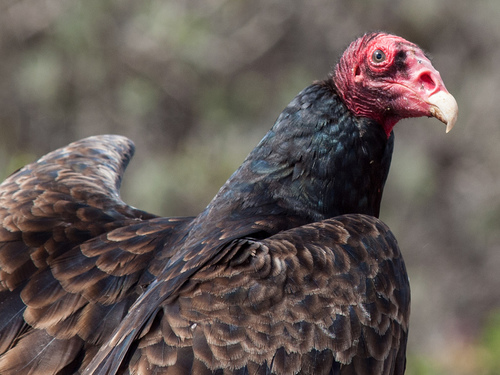Turkey Vulture
Cathartes auraCathartes aura 4
A large (26-32 inches) dark raptor, the Turkey Vulture is most easily identified by its dark brown body, featherless red head, and huge wingspan. This species may be separated from the related Black Vulture (Coragyps atratus) by that species’ smaller size, gray head, and shorter tail. Male and female Turkey Vultures are similar to one another in all seasons. The Turkey Vulture breeds across much of the United States (patchily distributed in the Great Plains) and southern Canada south to southern South America. Populations breeding on northern and interior portions of this range migrate south to the southern half of the U.S. for the winter. Populations breeding in the southeastern U.S., California, and the tropics are generally non-migratory. Turkey Vultures typically breed and roost in dense woodland while feeding in more open habitats, such as grasslands, meadows, and fields. In some areas, Turkey Vultures also utilize man-made structures, such as abandoned buildings and utility poles. This species feeds almost exclusively on carrion, rarely killing prey itself. Due to this species’ need to scavenge for food, Turkey Vultures are most easily observed soaring high above the ground in search of carrion. Scientists have discovered that this species possesses a more developed sense of smell than the Black Vulture, and that Black Vultures often wait for Turkey Vultures to find food before driving them off and taking the carcass for themselves. This species is primarily active during the day.
Conservation status 5
Turkey vultures are a common species throughout their range. The IUCN lists them as a species of Least Concern.
US Migratory Bird Act: no special status
US Federal List: no special status
CITES: no special status
State of Michigan List: no special status
IUCN Red List of Threatened Species: least concern
Habitat 6
Turkey vultures occupy a wide variety of habitats. They are found in forested as well as open environments. Turkey vultures can be found anywhere they can find their carrion food supply.
Habitat Regions: temperate ; tropical ; terrestrial
Terrestrial Biomes: tundra ; desert or dune ; savanna or grassland ; chaparral ; forest ; scrub forest ; mountains
Other Habitat Features: urban ; suburban ; agricultural ; riparian ; estuarine
Status 7
Classified as Least Concern (LC) on the IUCN Red List (1).
Sources and Credits
- (c) Franco Folini, some rights reserved (CC BY-SA), http://farm7.static.flickr.com/6224/7016463767_54579bb70b_b.jpg
- (c) tomsaint11, some rights reserved (CC BY), https://upload.wikimedia.org/wikipedia/commons/5/53/Cathartes_aura.jpg
- (c) Ed Dunens, some rights reserved (CC BY), https://www.flickr.com/photos/blachswan/33992035460/
- Adapted by Amanda Carrillo-Perez from a work by (c) Smithsonian Institution, some rights reserved (CC BY-NC-SA), http://eol.org/data_objects/34818138
- (c) The Regents of the University of Michigan and its licensors, some rights reserved (CC BY-NC-SA), http://eol.org/data_objects/31383982
- (c) The Regents of the University of Michigan and its licensors, some rights reserved (CC BY-NC-SA), http://eol.org/data_objects/25063934
- (c) Wildscreen, some rights reserved (CC BY-NC-SA), http://eol.org/data_objects/2600775








